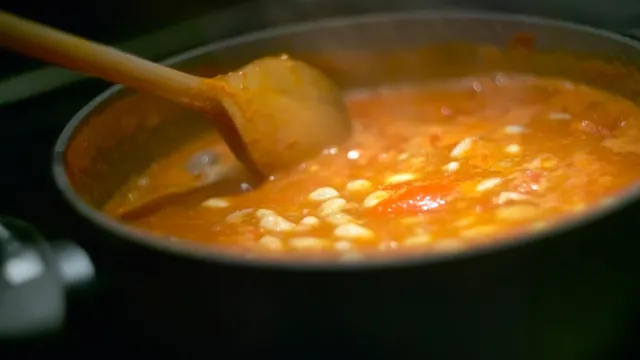If Your Beans Feel Like This, Don't Eat Them, Experts Warn
Beans with this texture could be toxic and lead to severe illness.

Beans are a delicious pantry staple that are always there in a pinch when you want to throw together a quick yet hearty meal. But while beans might seem completely harmless, experts warn that eating just a couple can have serious consequences if they haven't been prepared correctly. One way to know is by checking the texture. Read on to find out how to tell if you shouldn't be eating your beans.
RELATED: If You Notice This on a Potato, Don't Eat It, Experts Warn.
There is a toxin in beans that needs to be removed through soaking and cooking.

Although many people buy canned pre-cooked beans, others purchase dry beans to prepare themselves. Opting for dry beans is cheaper, produces less waste, and can help you moderate your sodium intake. However, experts warn that preparing your own beans could be dangerous if not done correctly.
"Raw beans … contain lectins, which are naturally occurring in plants, but the lectins in raw beans are toxic," family doctor Kristina Hendija, MD, explains. "Only through cooking, such as boiling, can the lectins be destroyed, and the beans will be safe to consume." According to the U.S. Food and Drug Administration's (FDA) "Bad Bug Book," eating "as few as four or five raw beans can trigger symptoms."
RELATED: Never Wash These 4 Foods Before Cooking Them, CDC Warns.
If your beans are still hard, don't eat them.

If you don't soak and cook your beans for long enough, you could get ill. Soaking your beans before cooking them is an essential part of the process to ensure you remove the lectins, but soaking by itself is not enough—you must also cook them thoroughly. What counts as thorough? "Cooked beans should be soft and tender," Hendija says. If your beans still feel hard after cooking them, don't eat them, and let them stew for longer.
Doctor and medical researcher Daniel Boyer, MD, has a special trick to help you know when your beans are safe to eat. "To know if your beans are done—blow on a spoonful of them," he says. "If their skins peel back, then they are done or almost done."
Follow the FDA's recommendations on how to prepare beans.

To be safe, at the very minimum, you should follow the FDA's recommendations when preparing your beans. Per the "Bad Bug Book," U.K.-based studies suggest that beans should be soaked in water for a minimum of five hours. At that point, you should swap out the tainted water for fresh water, and boil the beans for at least 30 minutes. The FDA warns you to never use a slow cooker for beans because the machine doesn't get hot enough to destroy the lectins.
RELATED: For more food safety advice delivered straight to your inbox, sign up for our daily newsletter.
Eating just a few improperly soaked or cooked beans can make you sick.

According to the FDA, many beans can be toxic if consumed raw or undercooked, including black, great Northern, kidney, and navy beans. Both Boyer and Hendija say red kidney beans are the riskiest to consume if not soaked and cooked properly, because they have the highest concentration of lectins.
The FDA's "Bad Bug Book" says that illness related to toxic beans "usually begins with extreme nausea and vomiting within one to three hours of ingestion of the product, with diarrhea developing later within that timeframe." According to the agency, the vomiting may become severe and could be accompanied by abdominal pain. And while you're likely to recover within three to four hours of the onset of sickness, the College of Food, Agricultural, and Environmental Sciences at Ohio State University notes that illness can sometimes result in hospitalization.
RELATED: The One Question You Should Always Ask Your Server Before Ordering, CDC Says.





















